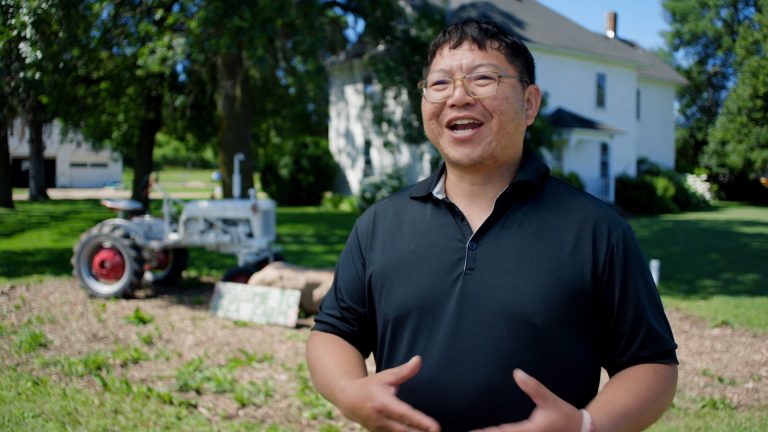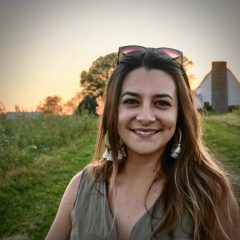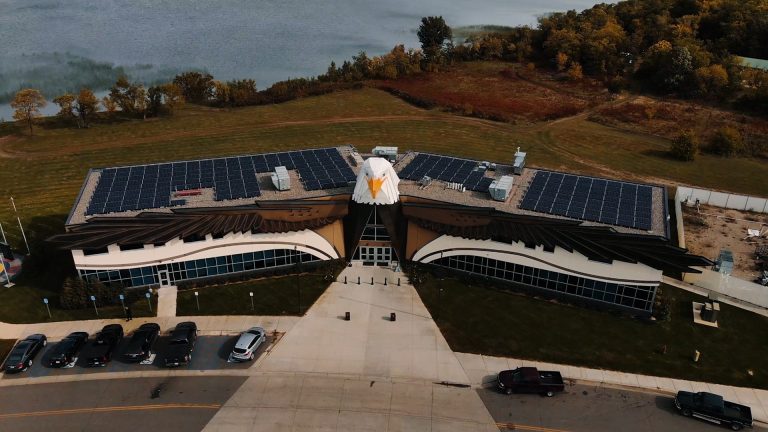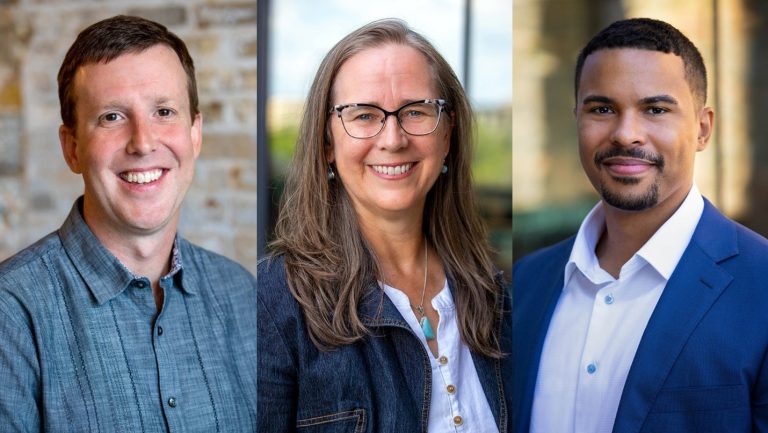Agriculture is a major part of the culture, livability, and vitality of rural communities in the Midwest. As a sector, it also accounts for 10% of the total U.S. greenhouse gas emissions, and even more in states like Minnesota and Iowa, where 25% and 30% of emissions come from agriculture.
What role can agriculture play in solving the climate crisis, and what are the most promising climate solutions rooted in the soil?
That was the topic of Dr. Lisa Schulte Moore’s conversation with Tenzin Dolkar during a recent Westminster Town Hall Forum. Over the last 10 years, Schulte Moore has developed and popularized the prairie strips conservation practice across 14 states and over 14,000 acres, integrating small amounts of prairie into strategic locations within corn and soybean fields to protect soil and water while providing habitat for wildlife.
Highlights from the Westminster Forum are included below. The interview has been edited for length and clarity. You can also watch the full event recording.
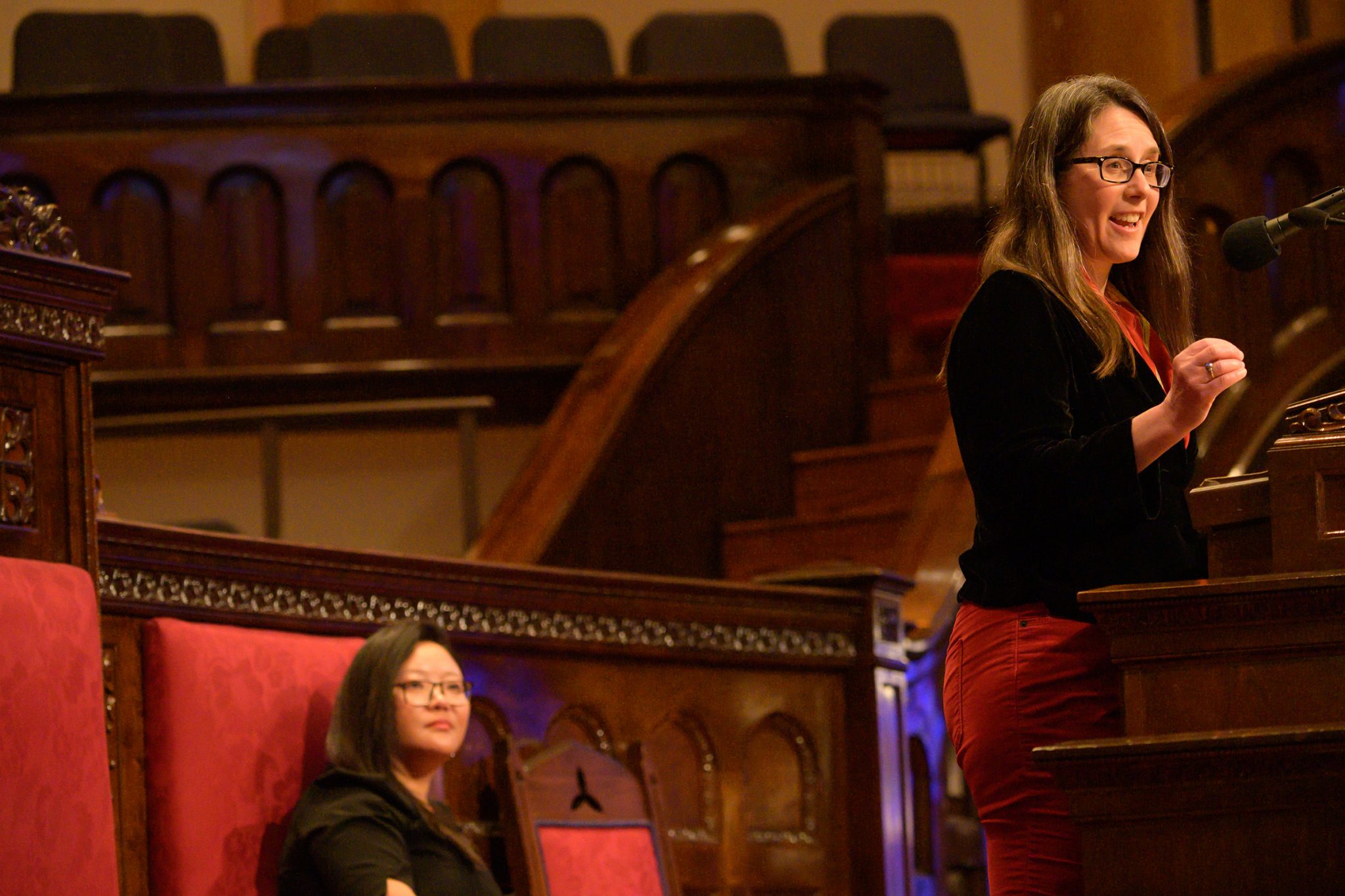
Tenzin Dolkar, McKnight Foundation (left) and Lisa Schulte Moore, Iowa State University (right) at the Westminster Town Hall Forum. Photo credit: Tom Northenscold
KEY TAKEAWAYS
- Rural communities are rooted in people and the land. While I’ve been at Iowa State University, I’ve been living, breathing, and learning about agriculture—and I am hooked by its people, by its bounty, and by its challenges. What I hear from farmers and rural residents through this work is that their journey begins and ends with people and the land. The agricultural landscape is home for them. They share stories of their farms, their heritage, the communities that they belong to, crops and water, the annual cycle of agriculture, and now also about prairie.
- Healthy soils are key to healthy food and a healthy environment. Why should you care about farmers and soil? Because we all need to eat, it’s really that simple. As farmer, writer, and activist Wendell Berry states, eating is an agricultural act. Yet for so many of us who live in the U.S. and other developed countries, agricultural abundance is so ubiquitous that it’s easy for us to forget that food doesn’t simply come from a grocery store. As a result we too often take for granted the climate, the fact that we get enough rain here the soil the water the nutrients the livestock and the people required to provide us with our daily sustenance. We are all part of the circle of life that today is nourished through agriculture.
- Keeping soils healthy means keeping them covered. Healthy soils not only provide food, they benefit all of our environment. Healthy soil helps us adapt to climate change by making us more resilient to drought and by acting like a sponge during heavy rainfalls, holding water in place and reducing downstream flooding. Most farmers already employ one or more soil health practices within their fields, like reducing tillage, armoring the soil with crop residues, maintaining continuous living cover, diversifying the plantings, and integrating livestock. Of these practices, maintaining continuous living cover is where I focus my career.
- We need to make regenerative agriculture mainstream. Core to regenerative agriculture is the idea that soil can be sustained and rejuvenated within a productive and profitable farming operation. While the concept is not new, mainstreaming it is. You can now find information about regenerative agriculture in widely accessible books like David Montgomery’s Growing a Revolution: Bringing Our Soils Back to Life, or by Minnesota’s own Brian DeVore, a book called Wildly Successful Farming, or on Minnesota Public Radio’s Field Work podcast, and even in a feature-length Hollywood film, Kissed the Ground. Farms of all sizes talk about how their efforts to become regenerative have made farming interesting again, figuring out how to balance short-term productivity with long-term soil health.
- Farmers need significantly more support. We need supportive farming communities so that farmers can learn from others like them at field days, workshops, webinars, and on social media, as well as through organizations like የአዮዋ የአፍሪካ ገበሬዎች, የመሬት ሽያጭ ኃላፊነት ፕሮጀክት, University of Minnesota, እና Iowa State Extension. We also need a supportive community of eaters speaking up for resilient food systems. Do your best in your busy lives to tune in not just once but three times a day to think about what you eat at meal times: where it came from and who produced it.
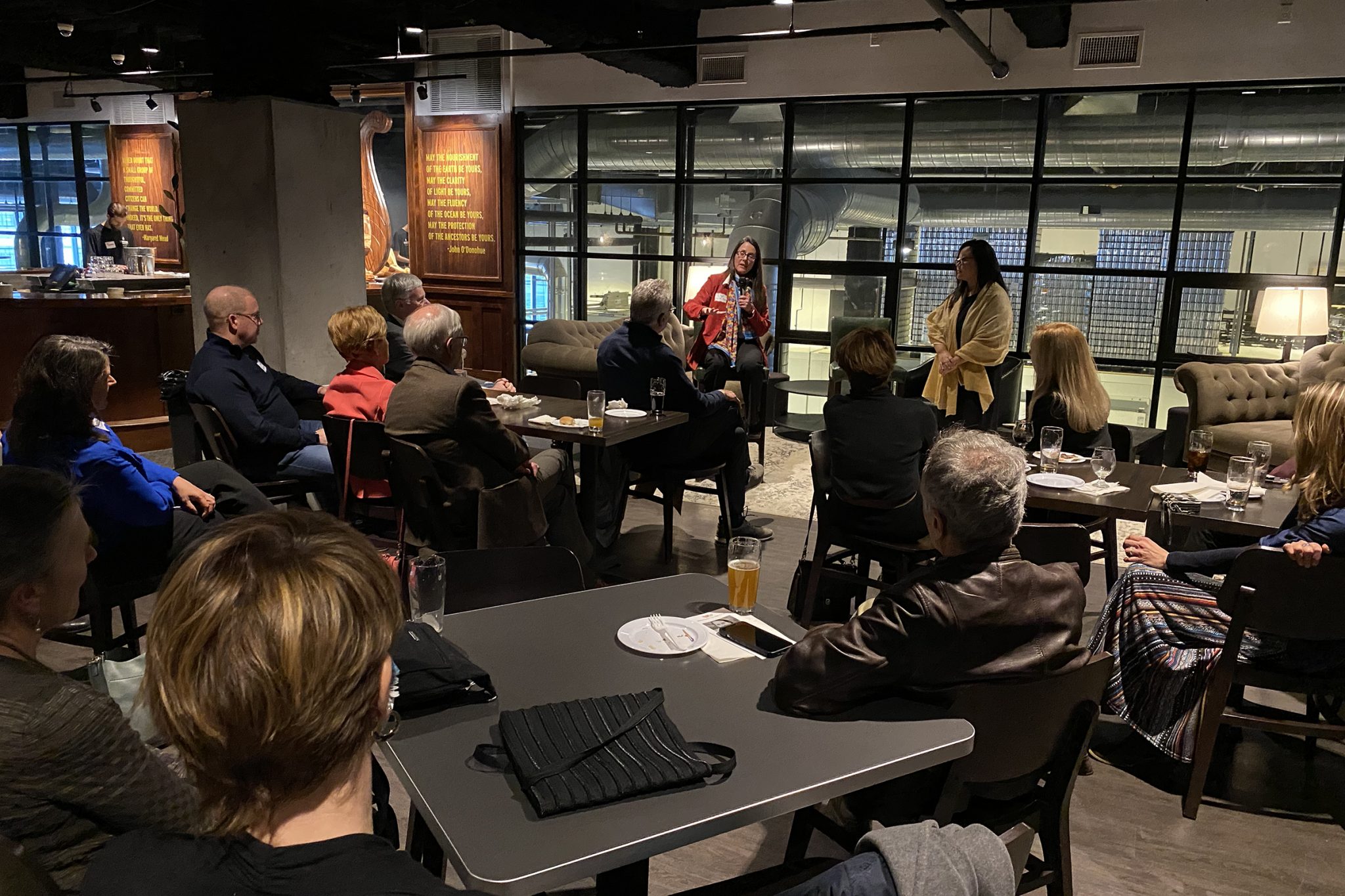
Dr. Lisa Schulte Moore and Tenzin Dolkar speak with agriculture leaders at Westminster reception. Photo credit: Tane Danger
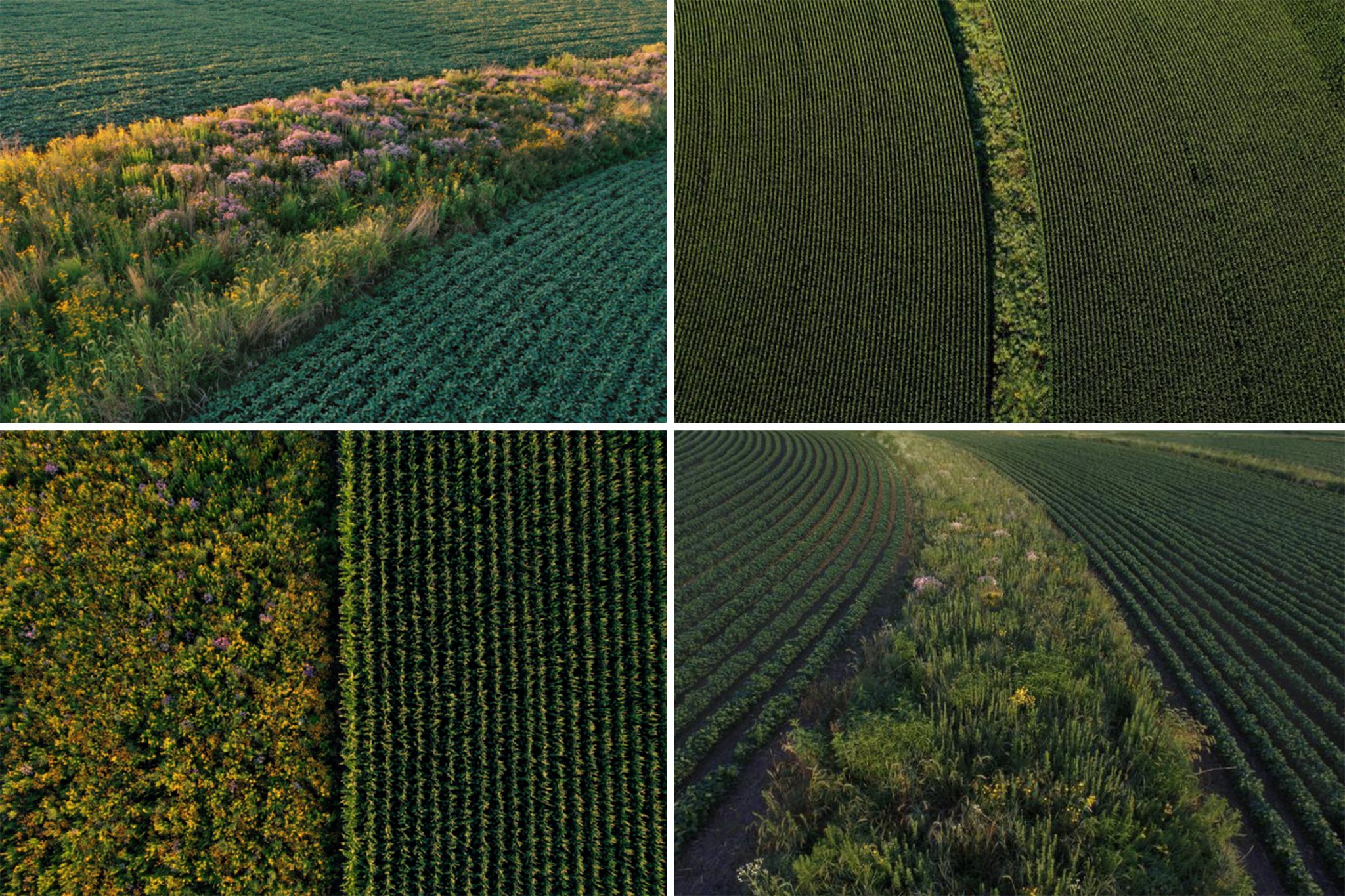
Examples of prairie strips woven into cropland in Iowa. Photo credits: Omar de Kok-Mercado, Iowa State University
CONVERSATION
Dolkar: 30% of greenhouse gas emissions in Iowa are from the agriculture sector. How do you scale innovative practices like prairie strips and others that you’re working on to reduce those emissions?
Lisa: It starts with conversations with farmers. And in our fractured, polarized world today we have to focus hard conversations about agriculture and climate change on the points where we agree. I have learned to begin by talking about soil—healthy, fertile soil—and ways to value it, ways to protect it, ways to regenerate it. Why? Because it’s something we agree is important. That way we do less finger pointing and can create shared bonds, develop understanding and empathy. From there we can start working together on small things, see some success, and build the track record and the trust needed to work on much, much larger things. And there are some pretty large things we need to work on.
When we look at scaling up, there are a few pieces to it. We know that all behavior change starts with awareness and then we need to move through change in attitudes to change in beliefs and change in behaviors. There are many different interventions that need to happen based on where someone is at in that spectrum.
With prairie strips, we’re actively working with farmers to integrate native prairie cover in their crop fields amidst the corn and soybeans. The conversation initially started with awareness, and my teams and I were fortunate to be supported by a host of institutions, including the McKnight Foundation, to conduct research on prairie strips, showing the impacts that even small amounts of prairie could provide when very smartly integrated into a crop field.
When we started sharing some of those results—like keeping 95% more of your soil in the field as opposed to letting it run off, keeping 77% more of the phosphorous that you paid for in the field, 70% of the nitrogen, doubling the bird biodiversity, tripling the pollinators—farmers came forward to say they liked the idea and that it connected with their values. They started working with us to integrate prairie strips on their farms.
It was a process to take a scientific concept and move it out onto a working farm where somebody’s making their living. We worked through some ups and downs and made it happen, and the farmers liked it. They liked what they were seeing and its impact on their fields, and they started talking about it.
The combination of the data we collected and the farmers talking about the practice positively added credibility that really opened a lot of people’s eyes. Without that, many of them never would have been willing to think about integrating prairie into their crop fields. Hosting field days so the farmers could show how it was working was big, too. Those three things in combination allowed for some policy changes, like a change in the USDA Farm Bill in 2018 that listed prairie strips for the first time as a practice eligible for the Conservation Reserve Program. This aligned the idea not only with farmers’ values, but also their pocketbooks, and that was really a critical piece in the behavior change.
In our fractured, polarized world today we have to focus hard conversations about agriculture and climate change on the points where we agree. I have learned to begin by talking about soil—healthy, fertile soil—and ways to value it, ways to protect it, ways to regenerate it. Why? Because it’s something we agree is important.DR. LISA SCHULTE MOORE, LANDSCAPE ECOLOGIST, IOWA STATE UNIVERSITY
Dolkar: What do we need to get right in the upcoming Farm Bill to support innovative practices that could really shift farming in the Midwest and Minnesota?
Lisa: As a scientist, my role is to provide good data and put it in the hands of people that can do advocacy and make good decisions. I really want to emphasize that now is a crucial time to get this right. There are a lot of things we could do to make the corn belt better, but the single best step is to figure out how to help farmers keep continuous living cover on the ground throughout the year. We need living plants in our soil throughout the year.
Dolkar: In the last few years in Minnesota we have seen extreme rain and extreme drought. How do you build a farming system that is climate resilient? What opportunities do you foresee for farmers, and what support do they need?
Lisa: I really think that soil health is the key when we talk about building climate resilient farming systems. Soil health is crucial for weathering storms and drought and still being able to produce nutritious food. It is in the farmer’s best interest to keep their soil healthy, not only for productivity, but also for passing to the next generation within the family or getting the soil quality valued before a transaction.
Dolkar: Can you discuss the role of commercial fertilizer in soil health and the impact on the environment and human lives?
Lisa: Synthetic ammonia is made through the haber bosch process from fossil fuels. As we think about the climate impacts of agriculture, nitrogen fertilizer is the elephant in the room. We really need to figure out how to minimize nitrous oxide production from agricultural lands while also producing sellable crops. We don’t have the scientific and management tools yet to do that quite right. I wish we were much further ahead in our science than we are.
That said, we do know a lot, and one of the things we can do is replace that synthetic commercial fertilizer produced with fossil fuels with green ammonia produced through an electrical process powered by renewable energy. We can also figure out how to manage cropland so that it’s not so leaky by putting the nitrogen fertilizer on the crops at a time when they are ready to use it. There’s a whole bunch of opportunity for innovation there.
We need to have some hard conversations about areas that shouldn’t be in production. Some are low-lying wet areas that tend to be hot spots for nitrous oxide emissions. One thing we can do is put in a little prairie there. That’s the conversation I’m having with farmers.
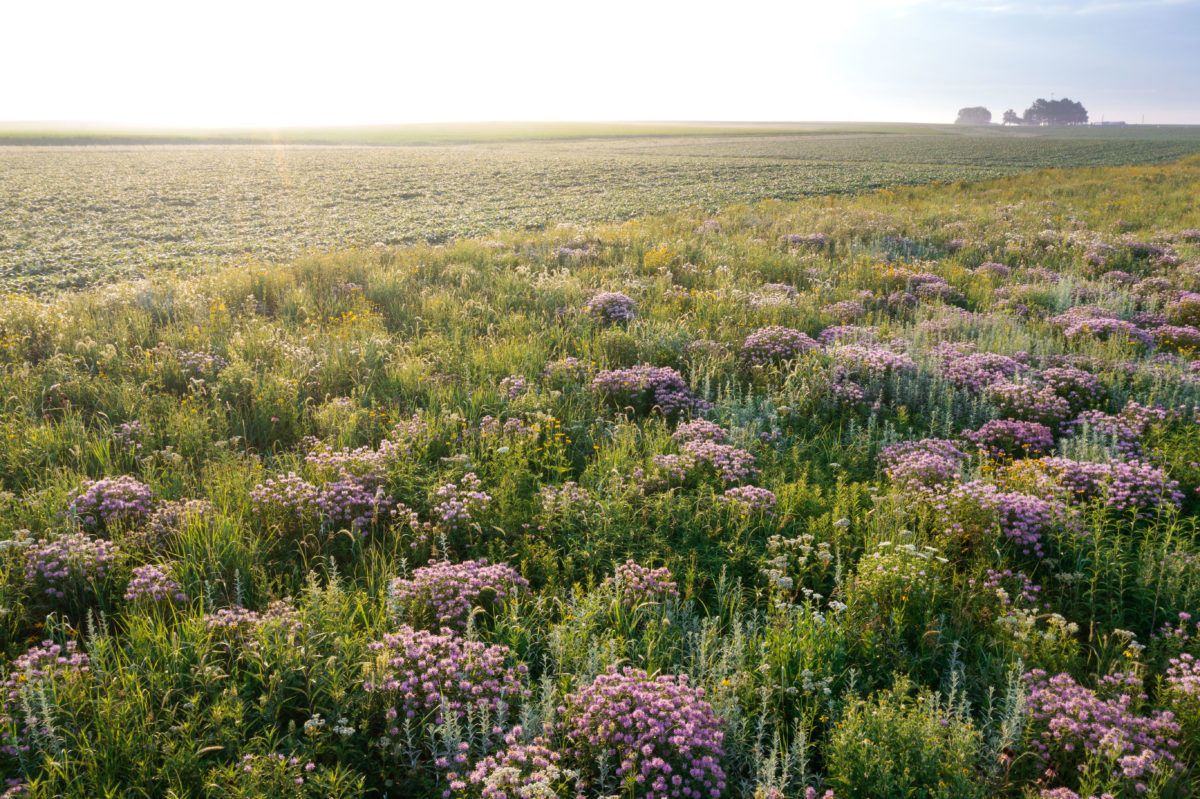
Prairie strip and soybeans on a private farm in Grundy County, Iowa. Photo credit: Omar de Kok-Mercado, Iowa State University
Dolkar: As a Midwest leader, within the context of our changing climate, what is your vision for farming in the U.S. in 2030 and in 2050?
Lisa: I’m speaking up with you here today, but what I really love to do is just listen. I love to go to field days. I love to go to farms and just listen to what people are talking about, ask them about their vision. We’ve done research projects where we show pictures and say, “Tell us what we got right here and tell us what we got wrong,” and “How would you make this landscape look with your vision?”
Through that process I’ve seen that there’s a lot of consensus in terms of the overall goal. From all different kinds of farmers to urban residents, we all want farming to be productive and have a lighter impact on the environment. Urban residents care a lot about water and climate, and the farmers talk about how they need new markets that will allow them to better protect the water and reduce inefficiencies on their farm (which is the way they would put it, rather than saying greenhouse gas reduction).
In my work I try to bridge these different points of view to figure out where we can agree and start working together. For instance, how can we expand prairie strips from being 10% of the landscape to 25% of the landscape? We know there are ways we can do that, but there are also barriers. There are not very many farmers who have the capital to do grass-based livestock production, which is a really important part of the puzzle. We also need to be able to create energy sources based on perennial herbaceous native plant cover so that farmers have another market that they can access with their prairie strip vegetation. I’m really hopeful, because we’re working with groups like Practical Farmers of Iowa who are embracing alternative energy to make those visions a reality.
Is there more we need to do? Could policy change help? Can infrastructure change help? Yes. So the last thing I ask you is to continue this conversation. I encourage you to connect with your local community groups that work with farmers who are also trying to bridge the rural-urban divide, and better support farmers and better advocate policies that make sense in that place.
About Dr. Lisa Schulte Moore: Schulte Moore is a MacArthur Genius Fellow and director of the Landscape Ecology and Sustainable Ecosystem Management Lab at Iowa State University. She is co-founder of the Science-based Trials of Rowcrops Integrated with Prairie Strips (STRIPS) project, which developed the prairie strips conservation practice. She is also lead developer of People in Ecosystems/ Watershed Integration (PEWI), a simple web-based educational game designed to help people understand human impacts on the environment and improve the management of natural resources. She directs C-Change, a United States Department of Agriculture National Institute for Food and Agriculture Sustainable Agricultural Systems project.
About Tenzin Dolkar: Dolkar is a program officer with the McKnight Foundation’s Midwest Climate and Energy program. McKnight’s working lands strategy centers farmers as the leaders of climate solutions and aims to co-create solutions that protect natural carbon sinks, cut emissions, and sequester carbon on working lands while building climate-resilient and just food systems. Prior to joining McKnight, Dolkar was a climate advisor to the City of Minneapolis, an agriculture policy advisor to former Governor Mark Dayton, and the State of Minnesota’s Rail Director.
